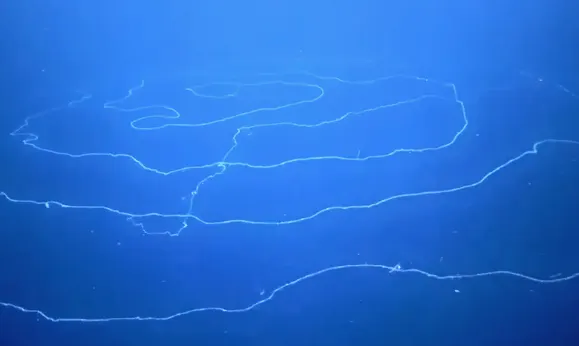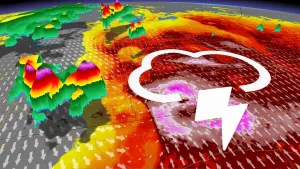
Creepy 154-foot long 'silly string' creature found in the deep sea
The siphonophore is a luminescent animal that can stretch over 150 feet in length.
A team of international researchers stumbled upon a mysterious, luminescent animal off the coast of Western Australia during the Ningaloo Canyons Expedition. The researchers were using remotely operated vehicles and SONAR technology to explore the area’s rich biodiversity when they came across a siphonophore, which they say could be the largest of its kind that has ever been recorded.
"It seems likely that this specimen is the largest ever recorded, and in strange UFO-like feeding posture," the Schmidt Ocean Institute wrote on Twitter. The institute estimates that it is roughly 47 metres (154 feet) in length and says that it was found at a depth of 630 metres.
This stringy creature is actually thousands of small organisms called zooids that have formed to live as a single entity. Each zooid has a specific function that contributes to the health of the siphonophore - some only have mouths with the sole purpose of ingesting food while others have enlarged hearts to circulate the shared blood. There can be dozens of zooids with the same function and they are arranged in repetitive sequences to optimize the division of labour.
Rebecca Helm, an assistant professor at the University of North Carolina Asheville, expressed how remarkable this finding was through a series of tweets.
"I've gone on numerous expeditions and have never, EVER, seen anything like this. Let me tell you what this is and why it is blowing my mind," Helm tweeted. "Most of the siphonophore colonies I've seen are maybe 20 centimeters long, maybe a meter. But THIS animal is massive. AND not just massive, the colony is exhibiting a stunning behavior: it's hunting."
“Siphonophores are a joy to study,” stated Dr. Casey Dunn, a professor of Ecology and Evolutionary Biology in a Current Biology article. Dunn explained that very little is known about this species and wrote that “one is just as likely to reach for a mid-19th century monograph or a paper that came out in the last year” since some research tools and approaches have remained unchanged since the 1400s.
While modern technologies are being used to study this species, their bodies are gelatinous and most of them disintegrate when they are sampled with nets, which makes it challenging for researchers to collect and study them.










